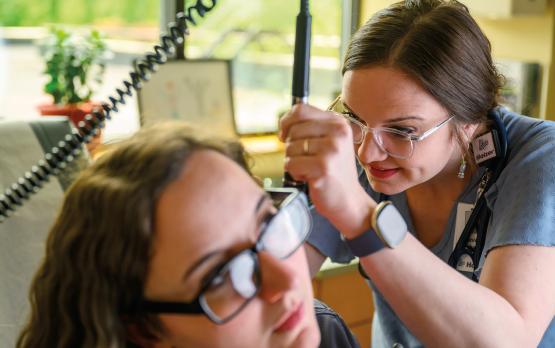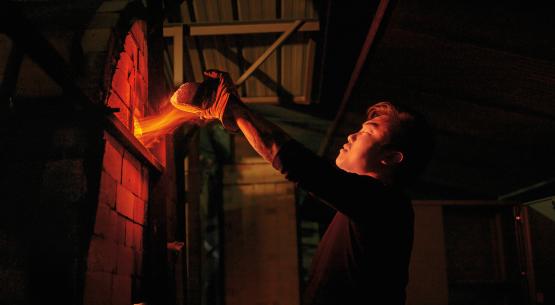
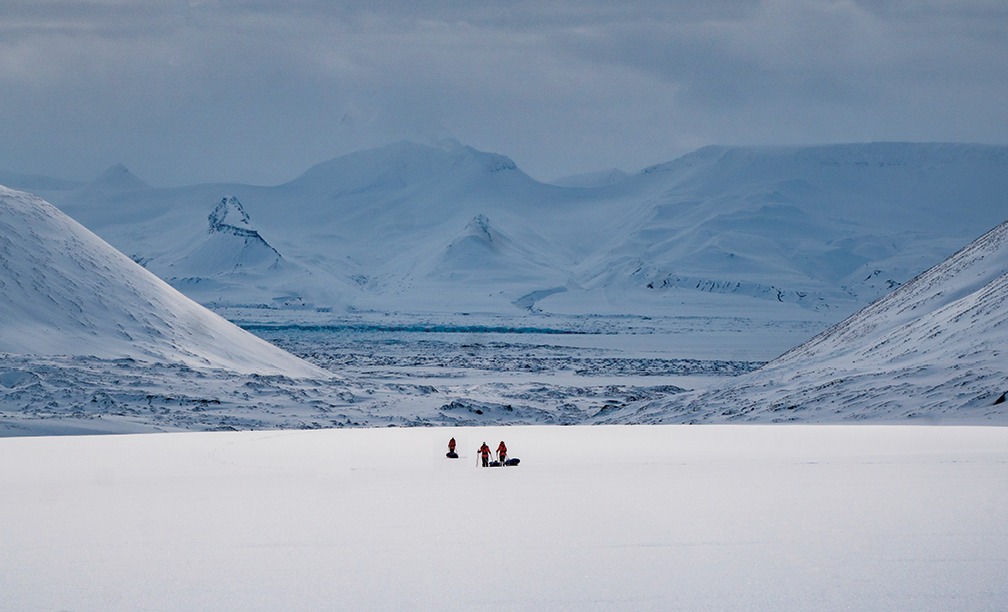
Sending in the Sentinels
The most memorable of great communicators all have one thing in common: passion. This essential ingredient helps bring even the most commonplace of topics to life, lending a surge of energy to the speaker’s words and moving the listener to take action.
Cat Hofacker, BSJ '18 | October 6, 2022
Share:
For Nina Adjanin, MSRSS ’18, MED ’20, PHD ’20, that topic—and her passion—is climate change and protecting endangered environments.
“No one is perfect, of course, but what we can do is try—for nature, for flora, for oceans, for mountains—because we need to protect it as much as we can,” says Adjanin, a three-time Ohio University Patton College of Education graduate.
Adjanin has the credentials—and the experiences—to back up her words.
In April 2021, after dozens of trips to extreme environments as a high-altitude mountain guide and later as a researcher, Adjanin embarked on a five-week expedition in the High Arctic as part of the first all-female research expedition in Svalbard, halfway between Norway and the North Pole. And if the 300-mile trek wasn’t already extreme enough, the expedition was carefully conceived to be the first that was carbon-neutral, requiring the researchers—four women from four countries—to travel only by foot and ski.
Designated the “Climate Sentinels,” the expedition’s mission was twofold. The first was gathering samples of snow, so scientists could measure concentrations of black carbon, or soot, emitted from sources around the world. Wind currents sweep black carbon toward the poles, contributing to a cycle of increased temperatures and severe weather events that, the United Nations’ Intergovernmental Panel on Climate Change warned earlier this year, requires “urgent action” to stop irreversible damage.
That need for action inspired the second part of the Climate Sentinels’ mission: documenting the expedition in a way that people could see the effects of climate change on this harsh environment few will ever experience firsthand. That’s where Adjanin—and the expertise she began developing at OHIO as a communicator and educator skilled in immersive experiences—came into play.
“I was the bridge between science and the general public and how we can use technology to tell the story of what is happening,” Adjanin explains of her role in the Climate Sentinels.
![Nina Adjanin [RIGHT] and her fellow “Climate Sentinels” collect snow samples in one of the fastest-warming regions on Earth. Photo by Heidi Sevestre](/sites/ohio.edu.news/files/2024-02/Fall-OTO-images-22_Nina2.jpg)
Nina Adjanin [RIGHT] and her fellow “Climate Sentinels” collect snow samples in one of the fastest-warming regions on Earth. Photo by Heidi Sevestre
Adjanin and her fellow scientists and explorers relied on immersive technology like small drones and 360-degree cameras, stored near their bodies to be kept warm as they skied for hundreds of miles in temperatures that, at their warmest, only reached about 6 degrees Fahrenheit. When pausing to gather snow samples, the sentinels would deploy the drone for five precious minutes at a time, the longest the electronics could function in the near-zero temperatures.
“Any picture is great, but through the use of technology, you are present there,” says Adjanin. “And maybe you can understand better how small you are compared with glaciers or polar bears.”
The journey was extreme by any metric, but in many ways, Adjanin had been preparing for it her entire life.
Born in Germany, she moved in early childhood to live with her grandparents in Bosnia, where the plentiful mountain ranges sparked a love of nature. That grew into a love of mountain climbing in Serbia, where her family relocated when Adjanin was 10 years old because of ongoing wars in the region.
The hobby blossomed into a career of sorts, leading Adjanin to become a high-altitude mountain guide, shepherding expeditions up some of the world’s tallest peaks, including Mount Everest and the greater Himalayas. It was during one of those trips that she saw something shocking—or rather, the lack of something.
“There was no snow. I mean it was dry; it was pure rock.” And if that was the case here, Adjanin wondered, “What is happening with the rest of the world? That’s when something triggered in my mind that something is happening with nature.”
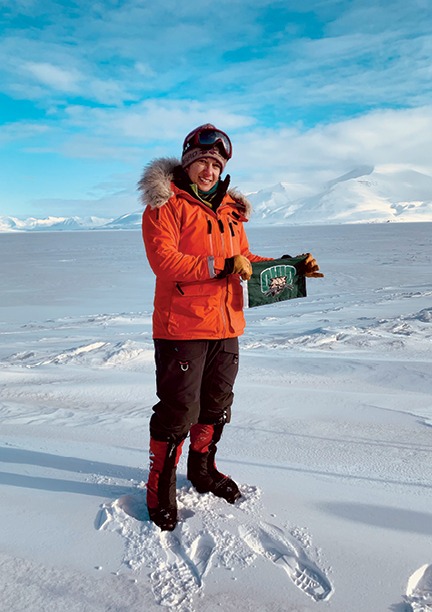
A member of the first carbon-neutral research expedition to the polar regions, Adjanin still managed to pack a little Bobcat pride, posing with an OHIO flag that made the journey with her. Photo by Heidi Sevestre.
If only everyone could see what she saw, Adjanin thought. She decided the answer was to pursue degrees in higher education, and, nine years after completing her bachelor’s degree in Serbia, she enrolled in OHIO’s Patton College of Education. She started out in outdoor and recreational studies, then decided a doctorate in instructional technology was the best way to “share that story with the world.” At the same time, her passion for statistics led her to pursue a second master’s degree in educational research and evaluation.
It was a two-week trip to the Arctic that Adjanin took during her first year as a doctoral student that showed her just how powerful technology could be. Using time-lapse and 360 cameras provided by OHIO’s Game Research and Immersive Design (GRID) Lab, Adjanin was able to record glacier movement.
“You look in one direction, and you can hear the sound of a moving glacier. Then you turn, and you can see it,” she says. “But it’s really dangerous for most people to be there in person, so this allows them to be there in a safe way.”
After returning from their expedition, Adjanin and the other Climate Sentinels have shared their experience with dozens of elementary schools around the world, including students in Athens.
“They always ask about the polar bears,” Adjanin says with a laugh, but the goal of this outreach is to inspire the students to be agents of change and to do things that will make a difference in the world. In moments she’s overwhelmed by the enormity of the challenge, it’s these discussions that give Adjanin hope.
“It’s unbelievable how great some of their ideas are,” Adjanin says of her interaction with young students. “Sometimes I believe they have better ideas than us, and that’s why we should allow them to be more creative and think about these big problems because the future is in their hands.”
But before handing the baton off to the next generation of scientists and communicators, Adjanin has more work to do. An assistant professor at Northwest Missouri State University, she is already planning her next research endeavor: a December trip to Indonesia to study tropical glaciers, whose high-altitude peaks are a vital source of water for local communities. The team Adjanin is working with is coordinating its efforts with local scientists who can continue the work after they have departed, empowering communities to protect the forces of nature that sustain them and the greater world.
“We want more people to be the voice of glaciers and nature,” Adjanin says. “If something is your passion, it’s easy to do.”
Feature photo: In April 2021, three-time OHIO graduate Nina Adjanin embarked on the first all-female, first carbon-neutral research expedition in the High Arctic, traveling only by foot and ski across 300 miles of glaciers, fjords and snowy peaks. Photo by Heidi Sevestre
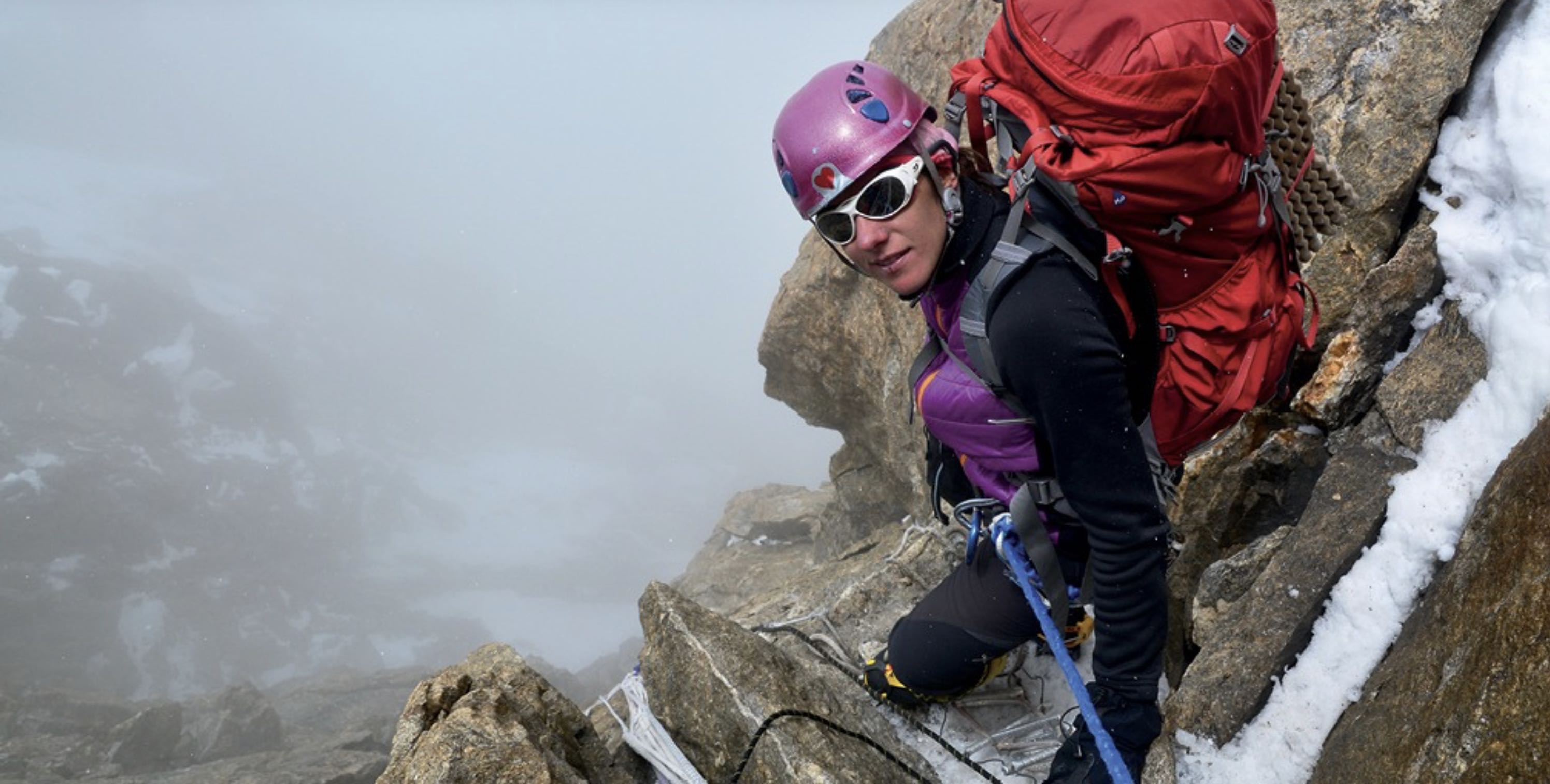
Inside Adjanin’s Adventures
Her 2021 expedition to the High Arctic may have been one of the most extreme journeys of her life, but it certainly wasn’t Nina Adjanin’s first time in uncharted territory.
Breadth of her travel and work: “Of the continents, I’m just missing Australia. And I’m just missing three U.S. states.”
Trip she’d most like to repeat: Climate Sentinels because it was so different—there are other people going to the Himalayas, for example, she says—and had such potential for impact. “It was just us in the Arctic.”
Most challenging trip: 2013 expedition in Pakistan. The Taliban attacked the group she was traveling with, killing 11 of the climbers. Adjanin escaped by hiding behind a rock. “The biggest dangers and threats in/on mountains are humans.”
Most educational trip: Her upcoming December trip to Puncak Jaya in East Indonesia to study one of the last tropical glaciers. “I’ve been climbing mountains for 20 years. Two years ago I learned about tropical glaciers, and they are all almost gone.”
Feature photo: As a high-altitude mountain guide and researcher, Nina Adjanin has conquered the tallest mountains on Earth, but her 2013 expedition up Pakistan’s Nanga Parbat was cut short by a deadly Taliban attack.

